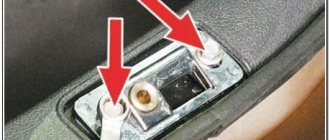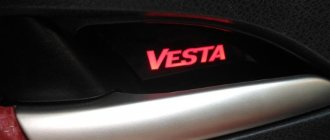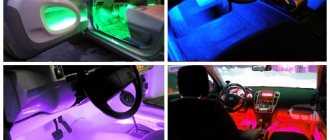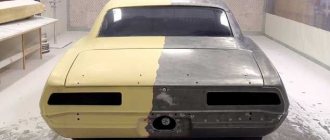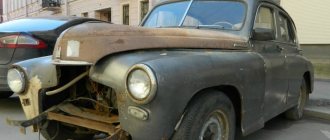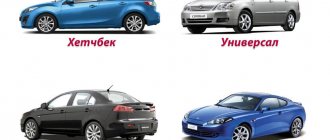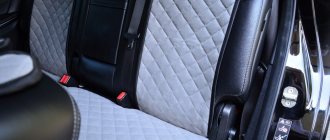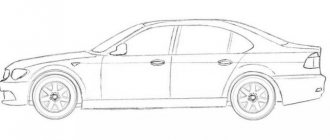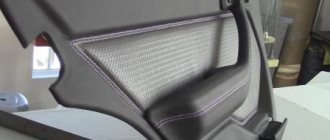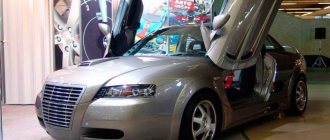All body doors are frame type and identical in design. The lower part of the door, i.e. its body, consists of two stamped panels (outer and inner), connected to each other by bending the edges and welding. To increase the rigidity of the door body, reinforcements are welded on the side of the hinges and the window sill. The upper part of the door is a U-shaped frame, butt-welded from two sections of profile formed by rolling a steel strip on a roller machine. The lower ends of the frame are passed inside the housing and connected to it using hard solder. The use of frame-type doors allows you to reduce the thickness of the door pillars and increase the area of the door window.
Rice. Fastening the doors to the body: a - section along the front door hinge; b — section along the hinge of the rear door; 1 — hinge cheek adjacent to the body; 2 — loop seal; 3 and 12 - holders; 4 - screw; 5 - plate; 6 — body pillar; 7 - plugs; 8 - bolts; 9 — door reinforcement; 10 — hinge cheek adjacent to the door; 11 — hinge seal on the door
On the outside, the door frames are lined with decorative aluminum trims, which are attached to the frames during assembly by bending the outer edge.
The outer decorative trim of the door window sill, in which the rubber glass seal is clamped, is put on the edge of the outer door panel and held on it by spring holders.
Door fastening
Each door at the front end is suspended from the body on two hinges. The cheek 1 of each hinge, adjacent to the body pillar b, is secured with screws 4 screwed into a plate 5 held inside the pillar by a holder 3. The dimensions of the holder allow the plate to be moved during adjustment. The hinge cheek 10, adjacent to the door, is attached to it with bolts 8, which pass through the holes in the door reinforcement V and are screwed into the threaded holes of this cheek.
To prevent dust from penetrating inside the front and rear doors, the cheek piece 10 of the hinge passes through a sponge seal 11, which is held by a holder 12 welded to the door. To protect the body from dust in the places where the front door hinges are attached, the cheek piece 1 of the hinge passes through a sponge seal 2 glued to the body pillar. and the mounting holes in the rack are closed with a rubber plug 7. The cheeks of the hinges are steel; They are made from a special rolled profile that is cut. The cheeks are connected with a finger. The finger is lubricated through the hole in the head of the cheek. The described fastening allows you to adjust the doors, that is, move them in any direction: up, down, forward, backward, inward and outward. This adjustment ensures the correct position of the door, determined by a uniform gap around the perimeter of the door and the absence of steps between the surface of the door and the areas of the body adjacent to it.
Rice. Door stop (horizontal section): I - door in open position; II - door in closed position; 1 - limiter; 2 — roller shank; 3 — limiter jumper; 4 — plate holder; 5 - plate; 6 — bracket; 7 - screw; 8 — door amplifier
Nissan Vmotion 2.0
A typical representative of suicide doors. They received this name for one feature: when passengers in the rear seat try to close the doors with fasteners on the rear pillar, they often fall out of the cabin.
@search.creativecommons.org
Another impractical point is that to open them in a parking lot, you must park 7 m from the nearest car, otherwise you risk simply not getting out of the car.
Door stop
To limit the opening angle and hold the door in the open position, each door is equipped with a spring stop 1. The ends of the stop, which serve as the axis of its rotation when opening the door, are attached to the body pillar with a bracket 6, which is secured with screws 7 screwed into a plate 5, held in place by a holder 4 , thanks to which the screws can be removed completely. The dimensions of the holder allow the plate to be moved when adjusting the door hinge.
When the door is opened, the shank 2 of the roller, mounted on the amplifier 8 inside the door, rests against the stopper loop, thus delaying further opening of the door. In this case, the limiter jumper 3, due to its elasticity, compresses the roller, preventing the door from closing under the influence of its own weight. The door opening angle with this design is not adjustable. To prevent the door from creaking, the stopper must be periodically lubricated.
Rice. Position of the lock and latch when closing the door: I - direction of door movement; II - direction of rotation of the rotor; a - the door is completely closed; b - the door is closed by one tooth; c — the door begins to close; 1 - rotor; 2 - latch; 3 - cracker; 4 — clamp; 5 — latch shelf
IFR Automotive Aspid CC
The Spaniards decided to have fun and invented a miracle Yudo with doors that open upward. There's just one problem.
@search.creativecommons.org
In order for the driver to leave the cabin, he has to not only fold them back, but also raise the roof. Otherwise there is no way to get out. This amazing technical solution is called the “butterfly”.
Door lock
All body doors have rotary locks of the same design. The lock holds the door in the closed position due to the fact that the rotor 1 is engaged with the toothed latch 2 mounted on the body pillar. The locks of all doors can be opened from outside the body by pressing the button on the outside handle, except for the front left door, and opened from inside the body by turning (up) the handle of the internal lock drive. When this knob is turned down, the lock is locked and cannot be opened from the outside. The left front door lock cannot be locked from the inside and can only be locked from the outside with a key using a lock located in the button on the outside handle.
The door lock, internal drive and gear latch are secured with screws. The lock mounting screws are screwed into the lock body, the drive screws are screwed into the fixed nuts of the door panel, and the latch screws are screwed into a plate held inside the post by a holder. This fastening allows you to remove the screws completely.
The outer handle is secured with two studs screwed into the handle and nuts.
The rotor 1 of the lock, made in the form of a six-tooth gear, rotates when opening and closing the door, rolling along the teeth of the latch 2. The rotor is held from rotation by a pawl 2, which is pressed against the ratchet 1, sitting on the same axis with the rotor, by the tension of the spring 3. When the door slams shut The rotor, resting against the latch teeth, rotates, overcoming the small force of spring 3, due to which the door closes with a slight push.
Rice. Door lock mechanism: 1 - ratchet; 2 - dog; 3 - spring; 4 - latch; 5 — lever foot; 6 — shelf of the lock body; 7 — pawl shank
The ability to freely roll the rotor along the toothed latch when closing the door allows you to slam all doors except the left front one, even when the inner handle is locked, i.e., in the lower position, which is very convenient if you need to close the door from the outside.
When opening the door, in order to free the rotor for rotation, the pawl 2 is moved away from the ratchet or the latch 6, pressing it with the bolt of the button 1 of the outer handle, or by lifting up the shank 7 of the pawl, turning up the handles of the internal drive of the lock (using the drive rod and the rocker arm in the lock ). When the drive handle is turned down, the rocker arm enters between the shelf 6 of the lock body and the foot b of the lever and locks the door, since when you press the button on the outer handle, the latch 4, resting against the rocker arm, cannot turn and move the pawl away from the ratchet. In the lowered position, the internal handles do not spontaneously return to their original position when the door slams, since this is prevented by the locking spring that holds the roller on which each handle sits in the extreme position. At the same time, the locking spring does not prevent the handles from returning to their original position when the door is opened from inside the body. Some force that must be applied to the handle when opening the door prevents it from opening if the handle is accidentally touched.
When a car moves on an uneven road, the body doors, which have significant weight (about 20 kg), create a large bending moment on the hinges due to the vertical movement of the body, i.e., an additional load that weakens the fastenings of the hinges and leads to their wear. As a result, the door sags, begins to knock while moving, and the tightness of the door seal is broken. To compensate for the bending moment on the hinges, the door lock, in addition to its main purpose, also serves as an additional support for the door. In the lock under the rotor, a latch 4 is fixed, which, when the door is locked, rests on the shelf 5 of the latch attached to the body pillar. To prevent the door from bouncing, the latch is clamped in the latch with a special movable plastic block 3. When the door is closed, in the correct position, the latch should smoothly enter the latch shelf without impacting and lifting the door upward.
The necessary tension of the door, i.e. its pressing against the body opening, is ensured by adjusting the position of the lock latch on the body pillar. By loosening the fastening screws, the latch can be moved and installed in the required position, after which the screws must be tightened well. The correct position of the latch relative to the door lock is controlled by the size of the mark that the latch leaves on the latch flange. The length of the trace should be no more than 25 mm. During operation, to ensure easy closing of doors and their proper sealing, it is necessary to periodically check and tighten the fastening of the hinges and lock latches of each door. If the mark left by the latch on the latch flange begins to deepen, this indicates a loosening of the door hinges and a violation of the correct position of the door, which must be restored immediately.
Rice. External door handle: 1 - button for the external handle of the left front door; 2 - spring; 3 — spring cup; 4 - bolt; 5 — cylinder protrusion; 6 - door lock latch
Purchased and self-made hinges
In order to tune a car, you will need to make Lambo hinges yourself or buy ready-made ones. It is advisable to first find out how much Lambo hinges cost in order to estimate the possible cost.
Making Lambo hinges for fastening doors
If you have the skills to perform plumbing work, you can try to make Lambo hinges with your own hands. To do this, you will need to find a drawing of a hinge suitable for a specific car model and purchase the necessary materials. You will need sheet metal and a gas shock absorber with the required rod length and load capacity.
External door handle
Button 1 of the outer handle of the left front door is equipped with a cylindrical lock that locks the button. When the key inserted into the lock is turned 90°, the lock cylinder rotates. In this case, the protrusions 5 located on the cylinder become across the slot in the bottom of the cup 3 of the spring 2 of the handle and thereby prevent the button from moving. With the exception of the lock button, all handles are interchangeable.
In order for the door to open unimpeded when you press button 1 of the handle, the button must move freely in the handle until it stops and return to its original position by the force of spring 2. If under these conditions the door lock does not open, then, consequently, push bolt 4 of the button does not reach latch 6 of the lock. For proper operation of the lock, it is necessary that a small gap of 0.3-1 mm be maintained between the head of bolt 4 and the latch 6 of the lock. If the bolt rests against the latch, then free angular movement of the door lock rotor will appear, which is unacceptable.
The position of the push bolt can be adjusted without removing the outer handle. To do this, you just need to remove the door trim and use the hatch that is in this part of the door. After installing the bolt in the correct position, tighten the bolt lock nut 4 well.
“Winged Legend”: facts about car doors that open upwards
Mercedes-Benz is a company that has earned respect at least because one of its creators stood at the origins of the global automotive industry. But the merit of this giant German concern lies not only in this. Mercedes is an innovative and technological company; it has many developments behind it.
One of these developments is one of the most unusual and memorable gullwing doors. Somehow it so happened that these doors are stubbornly associated with the legendary model of the mid-50s - first half of the 60s, Mercedes-Benz W198 300SL :
photo: ru.wikipedia.org
And really, didn't MB design these doors? Okay, maybe he didn’t develop it, but at least he applied it in series. Let's look a little into the past and make sure that not everything familiar can be called true.
photo: Mercedes-Benz / jalopnik.com
Door window. Release glass
The windows on all four body doors can be lowered and raised using power windows. The supports for the guide grooves along which the glass slides are the pillars of the door frames and additional pillars parallel to them, dividing the door window into two parts. In the front door, the dividing pillar is part of a non-removable frame of pivoting glass, which is attached to the door with three screws.
In the rear door, the dividing pillar is attached independently with two screws.
The guide grooves on the door frame pillars, as well as the upper groove into which the edge of the raised glass fits, are attached to the door frame profile with special spring holders. The lower ends of the grooves are held by a metal groove welded to the door with a hook at the end. The guide grooves on the dividing posts in the upper part are riveted to the posts, and in the lower part they are held by a hook riveted to the groove, which fits into the slot of the bracket 13 attached to the door.
The lower part of each sliding glass is pressed together with a rubber gasket into a steel clip 8, to which a bracket is welded, equipped with a clamp 5 for attaching the clip to the window lift cable 16.
Sterling Nova
The Sterling Nova model uses a rare type of car door – top-hung.
There are no doors as such - to get inside, you need to fold back the top of the car with integrated sidewalls. The convertible roof and car windows are hinged at the front and sides of the car.
Window lifter
For the sliding windows of 1 doors, the same window lifters with a cable drive are used. The glass lifters of the right and left doors are interchangeable, and the front and rear doors differ only in the length of the cable. The window regulator is secured to the door with three screws screwed into the window regulator body.
The window lift cable is fixed to drum 17 and in the working position is tensioned in the form of a triangle. The axis of the upper roller 4 is riveted to the reinforcement of the inner door panel.
The lower roller 14 is fixed in a fork 12, which is constantly pulled down by a spring 11 to compensate for the pulling of the cable. To reduce the friction of the cable on the side of the roller and ensure silent operation, the hook 10 of the fork is fixed at one point, as a result of which the plane of rotation of the lower roller 14 can deviate in accordance with the movement of the cable 16 along the grooves of the window lift drum 17.
Rice. Sliding glass and front door windows: 1 - glass; 2 — internal glass seal; 3 - window sill invoice; 4 - upper roller; 5 — cable clamp; 6 — external glass seal; 7 — external decorative trim; 8 — sliding glass holder; 9 — lower roller bracket; 10 - fork hook; 11 - spring; 12 - fork; 13 — buffer bracket; 14 - lower roller; 15 - buffer; 16 — cable; 17 - drum; 18 - handle
The cable and glass are moved by rotation of the drum using the window lifter roller gear and the drum ring gear 17.
The upward movement of the glass is limited by the glass resting on the upper groove fixed to the door frame. The downward movement of the glass is limited by the stop of the glass clip 8 in the rubber buffer 15, inserted into the bracket and fixed to the inner panel of the door.
The windows are fixed in any position by a brake spring placed inside the window lifter brake cup. The correct operation of the brake spring is checked by the amount of free play of the handle 18, which should be no more than 35 mm along the chord for the tip of the handle. Due to the fact that normal operation of the window lift can only be ensured with proper cable tension, elongated holes are made to attach the lower roller bracket 9 to the inner door panel, allowing the bracket to be installed in the desired position. Cable 16 must be well lubricated. If bracket 9 is loosened, the cable may come off the rollers and the window regulator will stop working. In this case, you should remove the inner handles and door trim, correct the position of the cable on the drum and rollers, pull bracket 9 down and secure it so that the cable is stretched like a string.
Rice. Pivoting glass of the front door: 1 — glass frame seal: 2 — pillar; 3 - nut; 4 - bracket; 5 - axis; 6 - spring; 7 — washer; 8 — seal for the open edge of the glass; 9 — bracket; 10 - button; 11 — handle; 12 — vaschelka
Pivoting front door glass
The rotary glass, which serves for ventilation of the front part of the body, is a separate unit, which is attached to the door frame with two self-tapping screws screwed into brackets 9, and to the door sill with one screw screwed into a fixed nut 3. The rotary glass of the front door is pressed together with the rubber - a new gasket into the rotating frame and holds firmly in it.
The rotating glass frame is equipped with a friction mechanism that locks the glass in any position, even with strong pressure from the oncoming air flow.
The ease of movement of the glass, which should turn with little hand effort, and the reliability of its fixation depend on how tight the spring 6 is, creating friction between the washer 7, put on the lower axis 5 of the turning frame, and the bracket 4 of the glass mounting frame.
Since the pivoting glass is assembled into one unit along with the installation frame and the window dividing post, if it is necessary to adjust the spring tension, the entire unit must be removed from the door, which can only be done after removing the armrest, internal door handles and its upholstery.
In the closed state, when the glass handle 11 is held by the latch 12, the glass frame and its open edge must be tightly pressed along the entire contour to the rubber seals 1 and 8.
The window handle has a locking device with a button 10, which prevents the locked handle from turning upward (from a horizontal position) and opening the window from the outside of the car using any hook. When you press the button from inside the body, the glass handle rotates freely. When lowered to the horizontal position, the handle locks without pressing the button.
Bertone Alfa Romeo Pandion
The Italian car is named after the bird of prey Pandion Haliaetus, which inspired the designers to create interesting opening doors. The Bertone Alfa Romeo Pandion has two doors, each of them is 3.6 meters long.
When opened, they rise up 90 degrees, the entire side of the car is a door - from the front to the rear wings. The doors have an interestingly shaped oblong glass, and when opened they rotate around the axis of the rear wheel.
Rear door glass
In the rear door window, due to the impossibility of completely lowering the glass due to the arched projection of the door above the wheel, the sliding glass is narrowed, and the additional glass, which is made fixed, is enclosed along the contour in a rubber seal.
Rice. Door seal: a - section along the top of the door window; b - cross-section along the B-pillar through the windows of the front and rear doors; c - cross-section along the door threshold; 1 - edge of the facing lining; 2 — external seal; 3 — arch of the headliner; 4 — internal seal; 5 — sliding glass; 6 - groove; 7 — door frame; 8 — threshold facing; 9 - outer door panel
Saturn SC2
Not only did they put suicide doors into this model, but they are also of such a microscopic size that a person of average build simply cannot squeeze through them.
@search.creativecommons.org
Who is this innovation intended for? Really, for dogs or cats? But they didn’t guess right! According to the developers, narrow doors are needed to make it easier to get to the trunk.
Door seal
All four doors have a double seal to protect the interior of the body from water and dust. The first seal is external, carried out by a continuous seal 2 made of sponge rubber, glued to the door along its entire perimeter, including the upper frames of the door 7. At the lock chord of the front door, the seal is additionally pressed with a steel lining.
The second seal 4 is internal, made in the form of an elastic, also continuous rubber profile, attached to the doorway of the body. In the lower part of the doorway, in the threshold area, the seal 4 is pressed against the flange of the opening by the threshold lining 8.
The rotating window glass is equipped with rubber seals 1 and 8. The sliding glass 5 is sealed with pile grooves 6 along which the glass slides, as well as with an internal pile seal 2 on the window sill 3 of the door and an external rubber seal 6 clamped in the lower decorative lining 7 of the door.
The effectiveness of the main outer door seal depends primarily on the tension (adjusted by the position of the lock latch on the pillar) at which the door closes with a slight push, and the sponge seals are deformed to the point that there are no gaps between them and the door. To do this, check the tight fit of the door seals to its opening by rubbing the seals with chalk. When the door slams, there should be a chalk imprint on the body.
If, with a well-adjusted door tension and correct operation of the lock, the chalk imprint is missing, then in these places you need to carefully separate the seal from the door and place a rubber pad of the required thickness under it with glue on it.
BMW Z1
The doors of the compact BMW Z1 Roadster have an original design - when opened, they slide into the threshold of the car.
For this, the most sophisticated technology developed by BMW was used; the opening took place using an electronic unit, but for safety reasons they also implemented a manual method of controlling the doors.

